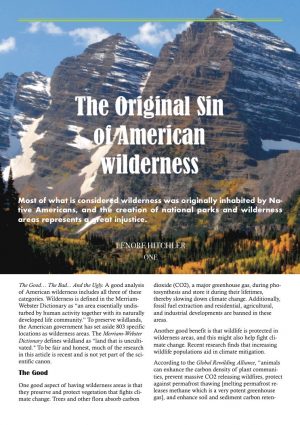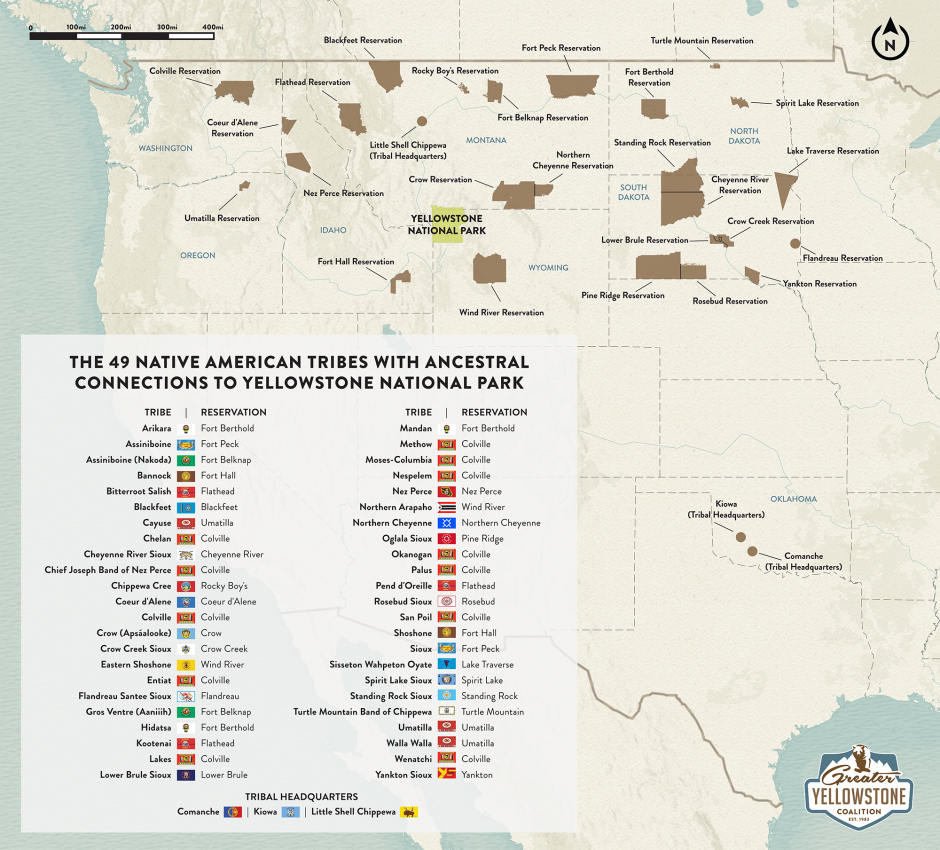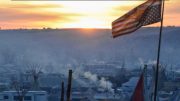 The Good… The Bad… And the Ugly. A good analysis of American wilderness includes all three of these categories. Wilderness is defined in the Merriam-Webster Dictionary as “an area essentially undisturbed by human activity together with its naturally developed life community.” To preserve wildlands, the American government has set aside 803 specific locations as wilderness areas. The Merriam-Webster Dictionary defines wildland as “land that is uncultivated.” To be fair and honest, much of the research in this article is recent and is not yet part of the scientific canon.
The Good… The Bad… And the Ugly. A good analysis of American wilderness includes all three of these categories. Wilderness is defined in the Merriam-Webster Dictionary as “an area essentially undisturbed by human activity together with its naturally developed life community.” To preserve wildlands, the American government has set aside 803 specific locations as wilderness areas. The Merriam-Webster Dictionary defines wildland as “land that is uncultivated.” To be fair and honest, much of the research in this article is recent and is not yet part of the scientific canon.
The Good
One good aspect of having wilderness areas is that they preserve and protect vegetation that fights climate change. Trees and other flora absorb carbon dioxide (CO2), a major greenhouse gas, during photosynthesis and store it during their lifetimes, thereby slowing down climate change. Additionally, fossil fuel extraction and residential, agricultural, and industrial developments are banned in these areas.
Another good benefit is that wildlife is protected in wilderness areas, and this might also help fight climate change. Recent research finds that increasing wildlife populations aid in climate mitigation.
According to the Global Rewilding Alliance, “animals can enhance the carbon density of plant communities, prevent massive CO2 releasing wildfires, protect against permafrost thawing [melting permafrost releases methane which is a very potent greenhouse gas], and enhance soil and sediment carbon retention through influence on microbial processes and chemical reactions.”
Retaining grasslands is another good because they are highly efficient at storing carbon. According to Dr. Cynthia Cambardella, a soil scientist with the Department of Agriculture, prairies store much more carbon below ground than a forest does above ground.
Still another good advantage of wilderness is its positive influence on people’s attitudes towards preserving the environment. Whether visiting or watching on television, viewers see how magnificent, beautiful, and truly awesome they are. People are fascinated and enthralled by wilderness scenery and wildlife, and then become interested in protecting it. A desire to preserve and improve the environment frequently leads to fighting climate change.
The Bad
However, the idea of a pristine wilderness is a myth, and it is bad. It was originally used to justify English colonialism. This is shown in an article in Natural History, which stated that: “when the lawyer John Winthrop took control of an English company in the Atlantic colonies in 1630, he declared that most land in America was vacuum domicilium—i.e., legally “waste”—because the Indians had not “subdued” it by methods recognized in English law and therefore had no “natural” right to it.”
Besides distributing land to settlers, the creation of both national parks and wilderness areas was ugly because the original inhabitants were forcibly removed. For example, to create Yellowstone National Park, 27 tribes lost their homelands, for Yosemite it was 7 tribes and 4 for Glacier National Park. The human rights of Native Americans were violated. They frequently were removed to remote locations, and they were not reimbursed as others are when their property is expropriated by the government.
Removing indigenous peoples to preserve wilderness is ironic as natives have a good record at maintaining biodiversity as shown by journalist Julia Rosen. She reported: “Studies show that, in many places, Indigenous lands host equal or higher levels of biodiversity than wilderness protection. … these landscapes exist at least in part because of human actions—not simply in spite of them. … A recent UN report found that Indigenous-held lands also experience less deforestation and store more carbon than surrounding areas. … Removing humans, on the other hand, can actually degrade ecosystems.”
Also, to specifically fight climate change, third-world countries are encouraged to set aside areas to offset the burning of fossil fuels by industrialized nations. This is ironic as, in the name of preservation, the very people who cause very little climate change lose their livelihoods, homes, communities, and homelands so that the people who have the largest carbon footprints can still produce more than their share of greenhouse gas.
Just as there are critics of the way that national parks and nature preserves are created, there are critics of the way that they are maintained. For example, some maintain that natural resources found in wilderness areas, such as minerals and fossil fuels, should be made available for use. One convincing argument is that the poor should not be deprived of the benefits of using these resources.
However, the other side of this is that those who own the extracting corporations are the ones who profit from those resources. In addition, the processes of extracting, refining, transporting, and disposing of wastes increase climate change.
The original preservationists did not recognize that what they perceived as wildlands had actually been created by Native Americans. These indigenous peoples had manipulated nature for their own purposes and created the very places that the environmentalists perceived as pristine. Yellowstone National Park itself is not an official wilderness area although part of it is managed as a wilderness.
Aston Chase was specific about Yellowstone, but his statement is true for all wilderness areas. He stated: “Created for the benefit and enjoyment of the people, Yellowstone destroyed a people. Dedicated to preservation, it evicted those who had preserved it. Touted as pristine, the policy required that we forget those whose absence diminished it. Denied its Indian past, it deprived us of the knowledge to keep it pristine.”
To make things worse, specific geographic areas were sometimes named after the very people who led massacres on natives. Within the park itself, a major Yellowstone summit was named after General Philip Sheridan. As part of the military campaign against Native Americans, Sheridan ordered an attack on a Blackfoot camp. This was despite the fact that the army had recently pledged protection for this group of women, children, and the elderly. Approximately two hundred Blackfeet were killed. Mount Doane in Yellowstone park was named after Gustavus Doane who was a US Army officer who took part in the massacre.
When indigenous peoples are removed from their homelands, their past does not usually become part of the common history of the nation. For example, it is not well-known that before Europeans came to North America, Native Americans had engaged in agriculture throughout the continent. The following information regarding pre-colonial Native Americans is lengthy and extensive. However, it is necessary to include this information because it is not familiar to people and has not been included in the history of North America. Also, it finally disproves the concept that indigenous peoples were nomadic hunters and gatherers who did not inhabit and tend the lands that the settlers wanted for themselves.

YNP Tribal Map. Image credit: Greater Yellowstone Coalition
The following long quotation by history professor Allan Greer, Ph.D. is an excellent summary of indigenous agriculture. He wrote: “There was, of course, agriculture in the pre-Columbian New World—indeed, the majority of the hemisphere’s population subsisted primarily through cultivating the soil … but it was purely crop-based: maize, beans, squash, and other cultivations were grown without a significant component of animal husbandry. Because crops did not share space with domestic animals, fences and hedges were largely unnecessary, and in that literal sense, the land was not enclosed. … North of Mexico lay a vast continent occupied by peoples who subsisted on various combinations of hunting, fishing, foraging, and agriculture. … Most land was held as a kind of commons. Maize cultivators of the northeast, including Iroquoians as well as the various Algonquian nations such as the Delaware and Narragansett, typically planted fields surrounding a village, relocating and clearing new lands every ten or twenty years. … Agricultural work and the distribution of the fruits of the harvest also had a strongly collectivist character (inner commons). Outside these small islands of cultivation, however lay terrain that provided vital supplies of game, fish, fruit, and other useful resources to those who knew how to harvest them (outer commons). … [the seventeenth-century missionary Gabriel Sagard wrote about the Huron Native Americans] ‘for all the forests, meadows and uncleared land are common property, and anyone is allowed to clear and sow as much as he will and can, and according to his needs; and this cleared land remains in his possession for as many years as he continues to cultivate and make use of it. After it is altogether abandoned by its owner, then anyone who wishes uses it, but not otherwise.’”
Further evidence of Native American agriculture is found in “Humanized Landscapes of the Americas Before 1492.” The authors stated: “By 1492 almost all American landscapes were marked by the human presence. … “domesticated plants such as maize (corn), beans, squash, tobacco—plants that cannot propagate without human intervention [were grown throughout North America] … [Native Americans] also manipulated the growth of many plants nearly everywhere, and, hence, transformed much of the American landscape by plant husbandry. … [Some indigenous agriculture was quite sophisticated and reflected a high degree of scientific knowledge.] Northern America, particularly in the upper Midwest, [contained] raised or ‘ridged’ fields. … Some of these have been found through experimentation to have been built to promote ‘cold-air drainage.’ That is, cold air is heavier than warm air and flows off of raised fields into adjacent ditches. Temperatures on the field surfaces are, therefore, warmer than surfaces and less prone to both early and late frosts.”
Even further evidence of Native American agriculture was provided by geography professor William E. Doolittle, Ph.D. He stated: “household garbage and other materials were often included in the mounds [of corn, beans, and squash throughout North America] as fertilizer. … [Early Europeans reported seeing fields that were both numerous and large] … Permanent or fixed fields, inter-cropping, and perhaps in some cases multi-cropping on an annual basis characterized nearly all of the east coast of North America from north of Cape Cod south to the Okefenokee Swamp; the bottom lands of the Mississippi, Missouri, Ohio, Tennessee, and St. Lawrence river valleys; areas north and south of Lake Ontario; some of the larger valley bottoms in the southern Appalachian Mountains; and patches along rivers flowing through the Great Plains. … “Fixed fields in the American Southwest, although small … were common in 1000 CE.”
Still even more evidence of Native American agriculture in areas that were considered wilderness is provided by Geography professor William Denevan, Ph.D. He wrote that throughout “North America, burning not only maintained open forest and small meadows but also encouraged fire-tolerant and sun-loving species. Fire created conditions favorable to strawberries, blackberries, raspberries, and other gatherable foods. … [burning by Native Americans burning] created ideal habitats for a host of wildlife species … exactly those species whose abundance so impressed English colonists: elk, deer, beaver, hare, porcupine, turkey, quail, ruffed grouse, and so on.”
Recent scholars have stated that grasslands were created by Native Americans. The anthropologist Omer Stewart stated: “The fact that Indians throughout America set fire to vegetation is firmly established.
The rich prairie soils were the result of the grass cover and the fact that the cover had been regularly burned off. … Grassy plains and prairies were present when the Europeans arrived in Illinois, Nebraska, Kansas, and Texas. … [the tall grass prairies stretched] from central Saskatchewan to the Texas Gulf Coast, almost 2000 miles, and from Indiana to central Nebraska.” He also stated that in 1952, mesquite covered an area of 75 million acres in the Southwest, and this whole area had formerly been set on fire by Indians. Thus, the preceding long passages about Native American agriculture debunk the wilderness myth.
Therefore, most of what is considered wilderness was originally inhabited by Native Americans, and the creation of national parks and wilderness areas represents a great injustice.
However, to be fair and honest, it must be pointed out that many European Americans are not aware of this past, and a good defense of this lack of knowledge can be made. Even the very definition of wilderness seems to verify the idea that these lands were pristine. Wilderness areas look like they have never been inhabited. These areas are filled only with vegetation and magnificent animals. The lack of any permanent architecture certainly reinforces this idea. Additionally, after early colonialism, evidence of native inhabitation would have been extremely difficult to find until recently when new tools of archaeology, such as aerial photography, were developed. Also, most people follow the mindset of their culture and believe what they are told by experts.
Many environmentalists believe that Native Americans left no traces and did not negatively affect the environment and therefore left us with pristine wilderness to cherish and protect even though Native Americans certainly had modified their environment. Instead of ignoring indigenous agricultural ways we could learn about their ways which are much more sustainable than industrial agriculture.
First-world countries would benefit by learning appropriate agricultural techniques from indigenous peoples, such as planting various species together. Perennial crops such as acorns and native wild berries, tubers, and plants that European Americans perceive as weeds could also be adapted for contemporary use. Relevant mindsets from indigenous peoples could be adapted to use in protecting the environment and combating climate change.
Lenore Hitchler




